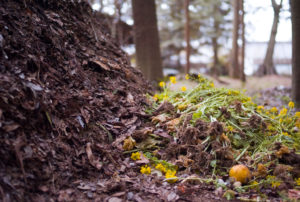
-Gabrial House-
Compost is one of the most nourishing and critical elements to a good organic garden. Compost not only feeds the plant in the garden it also feeds all of the wonderful creatures and bacteria that make living soil so vital and rich. Compost aids in aeration, water retention, as well as keeping the soil’s PH at a level the plants most prefer. Lots of good compost can even keep your plants disease- and pest-free!
Let’s take a look at what it takes to make good compost from scratch. The way that I think of compost is in two categories there is the “brown” category and the “green” category. The brown category is going to be the main source of carbon and the green category is the main source of nitrogen. It is important to have the right mix of both green and brown to have a healthy active compost pile. The easiest way to hit the right ratio of brown and green is to do a 50/50 mix of each. Having an equal blend will keep your compost working throughout the year. You will also find your end product to be less bogged down and wet.
For the brown element in my compost I use a number of different materials ranging from straw, autumn leaves, dried pea or bean vines, newspapers, or even dried cornstalks. My favorite is straw, as I always keep it on hand for chicken bedding, or mulch for my garden. It breaks down fast due to its hollow stalks.
For my green element, I use mostly kitchen scraps or garden scraps, you can also use grass clippings. When using grass clippings, it is important to remember that it is at a 50/50 ratio with brown matter, it can be easy to overdo it with grass clippings.
There are some items you want to avoid using in your compost such as seeded hay, roots of any cabbage family member as they can hold some forms of soil diseases that even the hottest of compost piles will not kill. You also should stay away from meat and dairy products and any oil waist from your kitchen.

Now that we know what materials to compost and at what ratios, the next step is how to properly compost them. It’s best to make a layered pile of brown and green material almost like lasagna, first with the brown carbon product, then a layer of green nitrogen product. Alternate back and forth between the two. In-between layers sprinkle in some soil from the garden or some compost starter to get the microbial activity working quickly. I always try to have the last layer I use for the day be the brown carbon layer. Leaving it on top works like insulation bringing the temperature up within the compost pile.
A good working pile of compost should get hot! A hot compost pile should be in the range of 90° -155°F. I regularly check my compost pile with a compost thermometer to make sure it’s still working away. This temperature will produce the largest amounts of compost fairly rapidly. The heat will kill many of the pathogenic organisms and any seeds from kitchen scraps or weeds. If you ever find that the pile is cooling down, get a manure fork and turn the pile, add more brown and green material and things should heat up again.
Compost truly is one of the best tools a gardener has for creating happy healthy plants. When I find I can’t make enough of it, I supplement my compost each year with organic bagged compost from McEnroe Organic. With my garden beds and containers full of good soil and lots of compost it is easy to have a productive bountiful harvest!

Leave a Reply